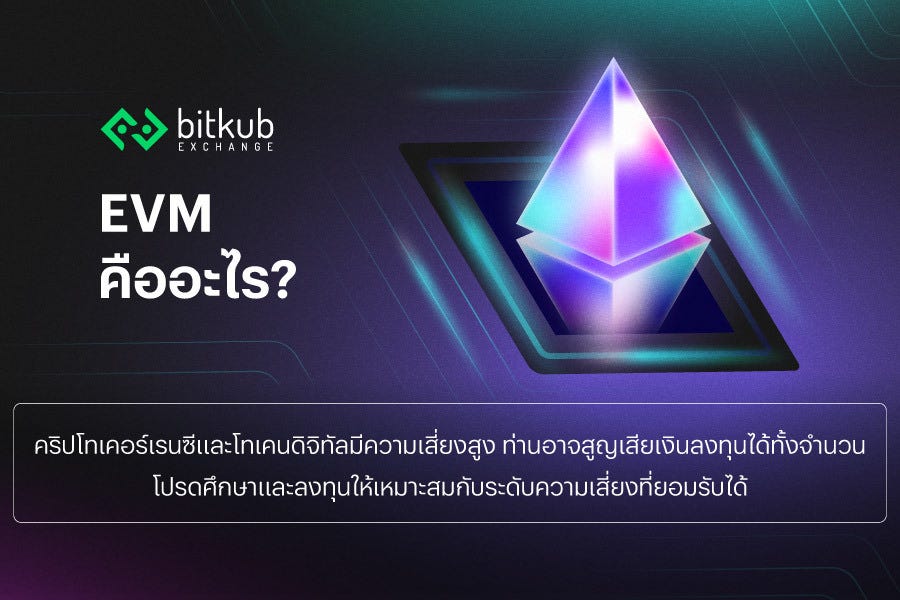Blog
รู้จัก EVM สิ่งที่ทำให้ Ethereum เป็นมากกว่าสกุลเงินดิจิทัล

หลายคนน่าจะรู้จัก Ethereum ในฐานะสกุลเงินดิจิทัลที่มีมูลค่าสูงที่สุดเป็นอันดับ 2* เป็นรองแค่ Bitcoin แต่รู้หรือไม่ว่านักวิเคราะห์บางคนเคยมีมุมมองว่า Ethereum อาจจะสามารถแซงหน้าบิตคอยน์ได้ในอนาคต เพราะด้วยคุณสมบัติในการเป็นแพลตฟอร์มที่เปิดในนักพัฒนาสามารถสร้าง Decentralized Application (dApp) ขึ้นบนบล็อกเชนได้
และส่วนประกอบสำคัญที่ทำให้ Ethereum รองรับการพัฒนาแอปฯ บนเครือข่ายก็คือ EVM นั่นเอง ในบทความนี้ Bitkub Blog จะมาสรุปให้ว่า EVM คืออะไร ทำงานอย่างไร และมีความสำคัญอย่างไร
EVM คืออะไร?
EVM หรือ Ethereum Virtual Machine ก็คือสภาพแวดล้อมรันไทม์ (Runtime environment) ที่ใช้สำหรับการเขียนสัญญาอัจฉริยะ (Smart contract) บนเครือข่าย Ethereum
อย่างที่ได้กล่าวไปข้างต้นว่า Ethereum ไม่ได้เป็นแค่สกุลเงินดิจิทัล เพราะมันสามารถถูกเขียนโปรแกรมเพื่อพัฒนาแอปฯ ได้ผ่านการทำงานของสัญญาอัจฉริยะ และการที่สัญญาอัจฉริยะจะสามารถทำงานได้อย่างถูกต้องก็ต้องอาศัย EVM นั่นเอง
หากจะอธิบายแบบง่าย ๆ ให้คิดว่า EVM ก็เป็นเหมือนกับระบบที่สามารถอ่าน ทำความเข้าใจ และดำเนินการตามโค้ดที่เขียนไว้ในสัญญาอัจฉริยะได้นั่นเอง
EVM ทำงานอย่างไร?
ก่อนอื่นมาทบทวนการทำงานของเทคโนโลยีบล็อกเชนกันสักหน่อย โดยบล็อกเชนเป็นฐานข้อมูลที่สำเนาข้อมูลจะถูกเก็บไว้ตามโหนดในเครือข่าย ข้อมูลเหล่านี้ไม่สามารถถูกแก้ไขย้อนหลังได้ สัญญาอัจฉริยะก็เช่นเดียวกัน เมื่อโค้ดของสัญญาอัจฉริยะถูกบันทึกลงบล็อกเชน สัญญาก็จะไม่สามารถถูกแก้ไขย้อนหลังได้ด้วย
เมื่อผู้ใช้ต้องการดำเนินธุรกรรมที่ต้องใช้สัญญาอัจฉริยะ ธุรกรรมดังกล่าวจะถูกประกาศไปยังเครือข่ายและถูกประมวลผลเพื่อดำเนินคำสั่งในสัญญาผ่าน EVM แต่การที่จะทำให้ธุรกรรมได้รับการประมวลผล ผู้ใช้ต้องมีการจ่ายค่าธรรมเนียมแก๊ส (Gas fee) ด้วย
เมื่อผู้ใช้ส่งคำสั่งทำธุรกรรม ผู้ใช้จะสามารถกำหนดเพดานค่าแก๊ส (Gas limit) เพื่อระบุว่าสามารถเสียค่าแก๊สเต็มที่ได้เท่าไหร่ ยิ่งกำหนดเพดานค่าแก๊สสูงก็จะยิ่งกระตุ้นให้นักขุดอยากประมวลผลธุรกรรมนั้นเป็นอันดับแรก ๆ แต่ถ้าไม่สามารถจ่ายค่าแก๊สได้ ธุรกรรมนั้นก็จะถูกตีกลับ เพื่อเป็นป้องกันไม่ให้มีข้อมูลธุรกรรมมากเกินไปจนส่งผลกระทบต่อความหนาแน่นของเครือข่ายนั่นเอง
ความสำคัญของ EVM
ความสำคัญของ Ethereum Virtual Machine ในระบบนิเวศของ Ethereum สามารถแบ่งอธิบายเป็นข้อได้ดังนี้
1.dApps: EVM ช่วยให้นักพัฒนาสามารถสร้างแอปพลิเคชันแบบกระจายอำนาจหรือ dApp บนบล็อกเชน Ethereum และทำงานร่วมกับเหรียญ Ether (ETH) หรือโทเคนบนเครือข่ายได้ ซึ่ง dApps สามารถนำไปประยุกต์ใช้ได้อย่างหลากหลาย ไม่ใช่แค่การเงินเท่านั้น แต่รวมไปถึงห่วงโซ่อุปทาน เกม การเก็บข้อมูล เป็นต้น
2.การทำงานร่วมกัน: เนื่องจากโหนดทั้งหมดในเครือข่าย Ethereum ต่างใช้ EVM จึงมั่นใจได้ว่าแต่ละโหนดจะดำเนินการตามสัญญาอัจฉริยะจะได้อย่างถูกต้อง
3.ความปลอดภัย: EVM มีการทำงานแยกออกจากข้อมูลบนเครือข่าย เพื่อป้องกันไม่ให้โค้ดที่เป็นอันตรายส่งผลกระทบต่อเครือข่ายได้ จึงสามารถช่วยลดการโจมตีและความเสี่ยงที่อาจเกิดขึ้นต่อเครือข่ายได้
4.มาตรฐานโทเคน: EVM ได้ก่อให้เกิดการสร้างมาตรฐานโทเคนต่าง ๆ เช่น ERC-20 ที่เป็นมาตรฐานของโทเคนส่วนใหญ่บน Ethereum หรือ ERC-721 ที่เป็นมาตรฐานของโทเคนที่เป็น NFT เป็นต้น
สรุป
EVM หรือ Ethereum Virtual Machine เปรียบเสมือนระบบที่สามารถอ่านและดำเนินการตามคำสั่งใน Smart contract ได้ ทำให้เกิดการพัฒนานวัตกรรมอย่าง dApps และอีกมากมาย EVM จึงเป็นส่วนประกอบที่สำคัญของระบบนิเวศของ Ethereum
อ้างอิง: Ethereum
_________________________________________
บทความ Bitkub Blog ที่คุณอาจสนใจ
รู้จัก Ethereum คริปโทที่ได้รับความนิยมเป็นอันดับต้นๆ ของโลก
อยากเป็นนักพัฒนาบล็อกเชนต้องเรียนภาษาโปรแกรมต่อไปนี้
อะไรคือ Digital Token ? ทำไมถึงนิยมขึ้นเรื่อยๆ
ไขทุกเรื่องราวเกี่ยวกับ Cryptocurrency ว่าคืออะไร และทำไมถึงน่าสนใจ ?
_________________________________________
มาเรียนรู้เรื่อง บิตคอยน์ (Bitcoin) และ Cryptocurrency ที่จะช่วยให้คุณเข้าใจโลกของคริปโทฯ ได้ดีขึ้น ที่ Bitkub Blog
*คริปโทเคอร์เรนซีและโทเคนดิจิทัลมีความเสี่ยงสูง ท่านอาจสูญเสียเงินลงทุนได้ทั้งจํานวน โปรดศึกษาและลงทุนให้เหมาะสมกับระดับความเสี่ยงที่ยอมรับได้
**สินทรัพย์ดิจิทัลมีความเสี่ยง โปรดศึกษาและลงทุนให้เหมาะสมกับระดับความเสี่ยงที่ยอมรับได้
***ผลตอบแทนของสินทรัพย์ดิจิทัลในอดีตหรือผลการดําเนินงานในอดีต มิได้เป็นสิ่งยืนยันถึงผลตอบแทน ของสินทรัพย์ดิจิทัลหรือผลการดําเนินงานในอนาคต”
_________________________________________
Get to know EVM: What makes Ethereum more than just a digital currency
Many people may know Ethereum as the second most valuable cryptocurrency after Bitcoin. But did you know that some analysts have had the perspective that Ethereum could potentially surpass Bitcoin in the future? This is because of its characteristic as an open platform where developers can create Decentralized Applications (dApps) on the blockchain.
One crucial component that enables Ethereum to support app development on its network is the Ethereum Virtual Machine (EVM). In this article, Bitkub Blog will summarize what EVM is, how it works, and why it is significant.
What is EVM?
EVM, or Ethereum Virtual Machine, is a runtime environment used for writing smart contracts on the Ethereum network.
As mentioned earlier, Ethereum is not just a digital currency; it can also be programmed to develop applications through the execution of smart contracts. The proper functioning of these smart contracts relies on the EVM.
To put it simply, you can think of the EVM as a system that can read, understand, and execute the code written in smart contracts.
How does the EVM work?
First, let’s review how blockchain technology works. A blockchain is a database where copies of data are stored across nodes in the network. This data cannot be retroactively altered. The same goes for Smart contracts. When the code of a smart contract is recorded on the blockchain, it cannot be retroactively changed.
When a user wants to execute a transaction that involves a smart contract, the transaction is broadcast to the network and processed to execute the instructions within the contract via the EVM. However, for a transaction to be processed, the user needs to pay a gas fee.
When a user sends a transaction command, they can set a gas limit to specify how much gas cost they are willing to bear. The higher the gas limit, the more it incentivizes miners to prioritize processing that transaction. But if the gas fee cannot be paid, the transaction is rejected. This prevents excessive transactions from clogging the network and affecting its efficiency.
The Importance of EVM
The significance of the Ethereum Virtual Machine (EVM) within the Ethereum ecosystem can be explained as follows:
1.dApps: The EVM enables developers to create decentralized applications or dApps on the Ethereum blockchain and interact with Ether (ETH) or tokens on the network. These dApps can be applied in various domains beyond just finance, including supply chain, gaming, data storage, and more.
2.Interoperability: Since all nodes in the Ethereum network use the EVM, there’s confidence that each node will execute smart contracts accurately.
3.Security: The EVM operates in isolation from the network’s data to prevent malicious code from impacting the network. This helps reduce the risk of attacks and vulnerabilities.
4.Token Standards: The EVM has fostered the creation of various token standards, such as ERC-20, a common token standard on Ethereum, and ERC-721 for non-fungible tokens (NFTs).
Summary
The Ethereum Virtual Machine (EVM) acts as a system that reads and executes instructions within smart contracts, leading to innovative developments like dApps and more. EVM is a crucial component of the Ethereum ecosystem.
Reference: Ethereum
_________________________________________
Disclaimer:
-Cryptocurrency and digital tokens involve high risks; investors may lose all investment money and should study information carefully and make investments according to their own risk profile.
-Digital assets involve risks; investors should study information carefully and make investments according to their own risk profile.
-Returns/Past Performance does not guarantee future returns/performance.
Source:
Medium